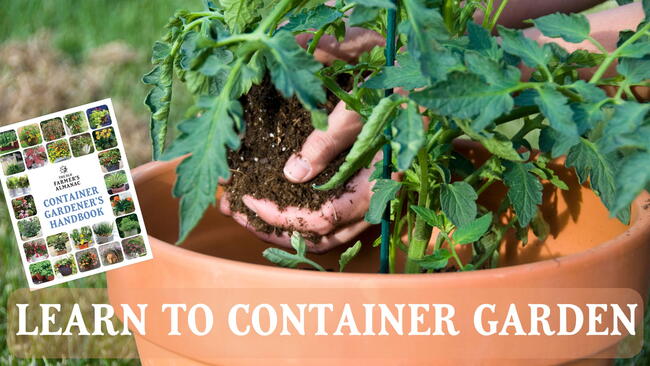Keep your foliage and flower container plants looking their best throughout the summer! Whether you have patio planters or window boxes, here are 10 tips to maintain your container garden and help you prepare your containers for colder weather.
Pretty planters are wonderful as a welcome entrance to your home. In addition, container gardening with edibles is a great solution for those who may not be able to have a traditional garden in the ground.
However, containers do need to be maintained. Little things can doom them, but attention to details will guarantee perfection.
Container Gardening Maintenance
- Mulch container surfaces to prevent soil compaction or root damage. Heavy rains and high-pressure hose blasts can dislodge potting mix and damage roots or pound the surface creating a hard crust through which water has a difficult time penetrating. Sphagnum moss, aquarium gravel, pebbles and shredded cedar bark are all attractive barriers that thwart these problems. Cedar bark has an added advantage. It contains a resin, which gives it a pleasant aroma that repels many insects. So does cocoa bean mulch.
- Pinch annuals when you plant to force branching. Impatiens and begonias especially benefit from an early pinch. Plants grow bushier and produce more flowers of better quality. Pinch again about six weeks later, after the first heavy flush of blooms is spent for another spectacular show. Pinch the flower stems back to just above a leaf or bud.
- Deadhead old flowers to promote new flower formation and to prevent seeds from forming which stops the bloom cycle. Geraniums (Pelargonium), dahlias, nicotiana, verbena and osteospermum, particularly, need deadheading. Prune leggy stems back to buds or branches and removing off-colored and damaged foliage.
- Water frequently. Since containers don’t benefit from ground moisture, it’s important to water as often as once daily. In hot, dry weather, you may need to water twice a day. This is especially true for closely-spaced plants packed into a small volume of soil. When you water, be sure to saturate all the soil in the pot-not just around the edges. If you find that your containers a drying out too quickly, perhaps you have too much plant for the soil in the pot. If your plants are crowded (or just look past their prime) pull them out.
- Fertilize regularly. In containers, there is limited soil and frequent watering so providing nutrients is essential for growing plants or they’ll weaken. Mix slow-release fertilizer pellets into the potting soil. Then, add additional nutrients throughout the growing season by dissolving a water-soluble fertilizer in the watering can once every week or two. Use a one-half to one-quarter strength dilution, or follow package instructions.
- Be a neat housekeeper and remove plant debris from containers. If left, decaying leaves and blooms often foster diseases and invite insects.
- Keep trailing and climbing plants in check by occasionally trimming them. Otherwise ramblers like dichondra, ivy, helichrysum petiolare and even petunias will climb over and smother their neighbors.
- Rotate containers to encourage plants on all sides to grow evenly and don’t get too leggy.
- As the seasons change, move your containers if necessary to keep the plants protected from very hot sun as well as sheltered from strong winds. Tip for future planting: Lighten the load of a heavy pot by filling the bottom quarter of huge pots with recycled foam peanuts that come in shipping cartons. Then, fill with potting mix. The peanuts create big air pockets and increase drainage, both things that encourage strong root development.
- You can keep your container going by changing out the plants as the seasons change. For example, plant bulbs and primroses in the spring, annual flowers and vegetables in the summer, and then pansies and colorful cabbage or kale in autumn.
Learn more about container gardening, including the best plants for containers.
Preparing for Winter
Most container plants aren’t winter-hardy. Even container perennials and trees can’t tolerate roots that freeze in their pots. Also, many types of pots will crack in frozen weather. (Consider choosing plastic pots that are non-porous and also reduce your watering chores during the season!)
If you live in a cold climate, you can treat your containers as annuals and throw them out or compost the soil. Or, you may be able to store your plants inside the pot in an unheated but not freezing garage or basement. See our advice on how to overwinter geraniums, roses, and other plants.
Also, remember to clean old containers thoroughly before using them for a second season. Add bleach to the wash water and use a scrub bush to get into cracks and crannies. A clean pot won’t transmit diseases to new plants. See how to clean and store pots for winter.










Comments